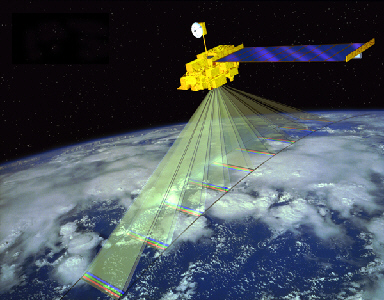

A Different Angle on Climate Change
by Patrick L. Barry
Look toward the horizon in almost any major city, and you'll clearly see the gray-brown layer of smog and air pollution. Yet when you look straight up, the sky can appear perfectly blue; you might think there's no smog at all!
The smog is overhead as well, but it's much harder to see. Why is there such a difference?
It comes down to viewing angles: A vertical line straight up through the atmosphere crosses much less air than a line angled toward the horizon. Less air means less smog, so the sky overhead looks blue. On the other hand, when you look toward the horizon, you're looking through a lot more air. The smog is easier to see.
A one-of-a-kind sensor aboard NASA's Terra satellite capitalizes on this angle effect to get a better view of how clouds and air pollutants scatter and absorb sunlight. By doing so, this sensor-called the Multi-angle Imaging SpectroRadiometer (MISR for short)-is helping scientists fill in a major piece of the climate change puzzle.
Most satellite instruments look only straight down at the Earth. Layers of airborne particles (called aerosols) and smog are harder to see with this vertical view, and clouds often appear only as two-dimensional sheets of white. Clouds and aerosols both can reflect incoming sunlight back out to space, thus cooling the planet. But they can also absorb sunlight and trap heat rising from below, thus helping warm the planet.
What is the net effect? MISR helps scientists figure this out by looking at the atmosphere at several angles-nine to be exact. Its nine cameras fan out across a range of angles from steeply looking forward (70.5 degrees from vertical), to straight down, to the same steep angle backwards. As the Terra satellite passes over a region, the cameras successively view the region at nine different angles.
From these data, scientists can construct a three-dimensional picture of the cloud cover, revealing much more about cloud dynamics than a flat image alone. They can also see light bouncing off aerosol pollution from nine different directions, thus getting a fuller picture of how aerosols scatter sunlight. And they can even spot thin layers of heat-trapping air pollutants that might go unnoticed by other satellites.
All this information comes just from looking at the atmosphere from a different angle.
For more information, see http://www-misr.jpl.nasa.gov . Kids can learn about MISR, see MISR images, and do an online MISR crossword at http://spaceplace.nasa.gov/en/kids/misr_xword/misr_xword2.shtml .
The MISR instrument on the Terra satellite views the atmosphere and Earth's surface from nine different angles.
This article was provided by the Jet Propulsion Laboratory, California Institute of Technology, under a contract with the National Aeronautics and Space Administration.
All content is the responsibility of LUNAR.
If you have comments or suggestions regarding these web pages,
please contact the 
Copyright © 1992 - 2025 LUNAR